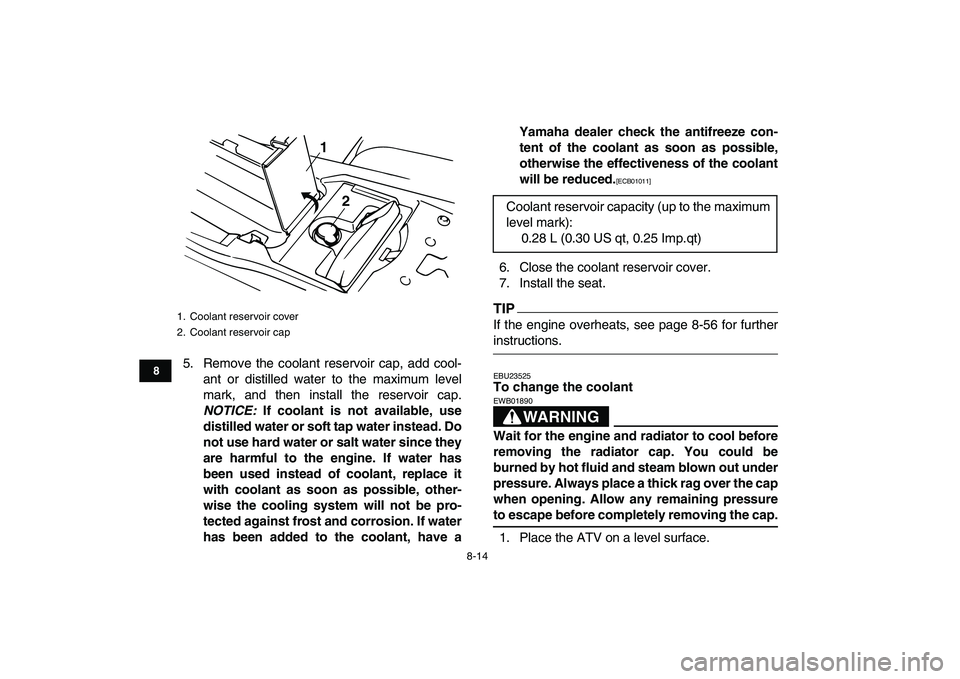Page 31 of 148
4-6
1
2
34
5
6
7
8
9
10
11
wise, the engine will misfire, preventing normal op-
eration.
WARNING
EWB00220
�
Always set the parking brake before starting
the engine. The ATV could start moving un-
expectedly if the parking brake is not ap-
plied. This could cause loss of control or a
collision.
�
Always be sure you have released the park-
ing brake before you begin to ride. The brake
could overheat if you ride the ATV without re-
leasing the parking brake. You could lose
braking performance which could cause an
accident. You could also wear out the brakes
1. Button
2. Parking brake lock plate
1
2
1. Locked position
1
Page 54 of 148
6-5
1
2
3
4
56
7
8
9
10
11
ances. During this period, prolonged full-throttle
operation or any condition that might result in en-
gine overheating must be avoided.
0–160 km (0–100 mi) or 0–10 hours
Avoid prolonged operation above 1/2 throttle. Vary
the speed of the ATV regularly. Do not operate it at
one set throttle position.
160–320 km (100–200 mi) or 10–20 hours
Avoid prolonged operation above 3/4 throttle. Rev
the engine through the gears freely, but do not use
full throttle at any time.
320 km (200 mi) or 20 hours and beyond
The ATV can now be operated normally.
NOTICE
ECB00220
If any engine trouble should occur during the
engine break-in period, immediately have a
Yamaha dealer check the ATV.
EBU20722
Parking
When parking the ATV, shift into first gear, stop the
engine, apply the parking brake, and then turn the
fuel cock to “OFF”.
1. Button
2. Parking brake lock plate
1
2
Page 92 of 148

8-14
1
2
3
4
5
6
78
9
10
11
5. Remove the coolant reservoir cap, add cool-
ant or distilled water to the maximum level
mark, and then install the reservoir cap.
NOTICE:
If coolant is not available, use
distilled water or soft tap water instead. Do
not use hard water or salt water since they
are harmful to the engine. If water has
been used instead of coolant, replace it
with coolant as soon as possible, other-
wise the cooling system will not be pro-
tected against frost and corrosion. If water
has been added to the coolant, have aYamaha dealer check the antifreeze con-
tent of the coolant as soon as possible,
otherwise the effectiveness of the coolant
will be reduced.
[ECB01011]
6. Close the coolant reservoir cover.
7. Install the seat.
TIP
If the engine overheats, see page 8-56 for further
instructions.
EBU23525
To change the coolantWARNING
EWB01890
Wait for the engine and radiator to cool before
removing the radiator cap. You could be
burned by hot fluid and steam blown out under
pressure. Always place a thick rag over the cap
when opening. Allow any remaining pressure
to escape before completely removing the cap.
1. Place the ATV on a level surface.
1. Coolant reservoir cover
2. Coolant reservoir cap
1
2
Coolant reservoir capacity (up to the maximum
level mark):
0.28 L (0.30 US qt, 0.25 Imp.qt)
Page 99 of 148

8-21
1
2
3
4
5
6
78
9
10
11
8. Check the sponge material and replace it if
damaged.
9. Apply Yamaha foam air filter oil or other qual-
ity foam air filter oil to the sponge material.
TIP
The sponge material should be wet but not drip-
ping.
10. Pull the sponge material over the air filter ele-
ment frame, and then install the lock plate by
turning it.
11. Insert the air filter element into the air filter
case, and then install the air filter case cover
by hooking the holders onto the air filter case.
NOTICE:
Make sure that the air filter ele-ment is properly seated in the air filter
case. Never operate the engine with the air
filter element removed. This will allow un-
filtered air to enter the engine, causing rap-
id engine wear and possible engine
damage. Additionally, operation without
the air filter element will affect carburetor
jetting with subsequent poor performance
and possible engine overheating.
[ECB00461]
12. Install the seat.
TIP
The air filter element should be cleaned every 20–
1. Air filter element
1
Page 135 of 148
8-57
1
2
3
4
5
6
78
9
10
11
Engine overheating
WARNING
EWB02290
Wait for the engine and radiator to cool before removing the radiator cap. You could be burned by
hot fluid and steam blown out under pressure. Always put a thick rag over the cap when opening.
Allow any remaining pressure to escape before completely removing the cap.
TIP
If coolant is not available, tap water can be temporarily used instead, provided that it is changed to the rec-
ommended coolant as soon as possible.
Wait until the
engine has cooled.
Check the coolant level in the
reservoir and radiator.
The coolant level
is OK.The coolant level is low.
Check the cooling system
for leakage.
Have a Yamaha dealer check
and repair the cooling system.Add coolant. (See TIP.)
Start the engine. If the engine overheats again, have a
Yamaha dealer check and repair the cooling system.
There is
leakage.
There is
no leakage.